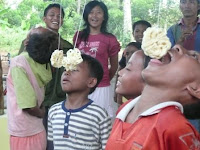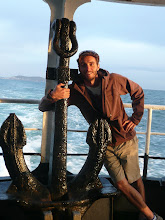Merdeka is a word pregnant with meaning for Indonesian people. Its translation is freedom. This three-fold idiom is shouted on this day as a powerful poetic reminder of the cries of its people, who declared their independence on the 17th August, 1945. It wasn’t until 1949, however, that the Dutch finally accepted this declaration and gave Indonesia freedom throug h independence.
h independence.
 h independence.
h independence. Hari Kemerdekaan translates as Independence Day. Thus, in the Indonesian language, independence is understood as an expression of freedom.
This year Hari Kemerdekaan fell on a Sunday, thus a public holiday was given on the following Monday. On this day, Bridge of Hope, in collaboration with the local leaders organized a day of games and activ ities for the people of Sumompo.
ities for the people of Sumompo.
This year Hari Kemerdekaan fell on a Sunday, thus a public holiday was given on the following Monday. On this day, Bridge of Hope, in collaboration with the local leaders organized a day of games and activ
 ities for the people of Sumompo.
ities for the people of Sumompo. The games included a marble and spoon race (a creative rendering of Egg and Spoon conducive to a culture of excess!), a sack race (using bags used for collecting rubbish!), prawn crackers on a string (similar to doughnuts on a string), pen into a bottle (an hilarious game where the pen is dangling from a string behind the person who has to squat like going to the toilet to fit the pen into the bottle!), and finally Panjat  Pinang.
Pinang.
Panjat Pinang is the highlight of the day, and the only game uniquely Indonesian. Here a Pinang tree is stripped of its branches and glazed with grease from bottom to top. At the top is a collection of prizes. Providing for both young and old there was provided a shorter banana (pisang) tree for the children. The children were to go first on their Pisang tree.
Around 20 eager boys stripped themselves of their shirts and lined up to reach their prize. The first few boys tried with energy and conviction to obtain their prizes just several metres from their reach. Yet, each time they were helpless to the slipperiness of the grease. Jumping and striving, clutching and climbing, they were willing to give everything despite gaining nothing. These boys, however, prepared the way for others by gradually ridding the tree of grease. Each time, the next pair would make it a few more inches up to their goal.
stripped themselves of their shirts and lined up to reach their prize. The first few boys tried with energy and conviction to obtain their prizes just several metres from their reach. Yet, each time they were helpless to the slipperiness of the grease. Jumping and striving, clutching and climbing, they were willing to give everything despite gaining nothing. These boys, however, prepared the way for others by gradually ridding the tree of grease. Each time, the next pair would make it a few more inches up to their goal. 
After 20 minutes of enjoyment and laughter, the crowd turned its’ attention to the Pinang tree as three boisterous men climbed upon each others shoulders in a rush of unruly initiative. The crowd was uproarious as they could almost feel the pain felt by the man at the bottom supporting the weight of two men above him. After 5 minutes of intense struggle they came to a crashing end. Next came a triplet with a little more innovation. They brought tools with them! The man on the top had his friend’s shirt to soak the grease and then used dirt sagging from within his tucked shirt to further provide friction for his next intended ascent. Within a few minutes they had reached their goal. Instead of reaping all the rewards, each group is only allowed three prizes to take, and then leave the rest for the next group.
Unfortunately the boys didn‘t learn from their elders and continued to struggle in pairs to reach the top without shirt or dirt. Yet, after digging their hands into the trunk of the tree they were able to make it to the top.
Panjat Pinang is a game that teaches team-work, interdependence, sharing, and provides great entertainment for spectators. The efforts of the initial groups could be seen as failures except for the fact that they played pivotal roles in preparation for the successful groups.
This celebration of Hari Kermerdekaan was enjoyed by all, and was a tribute to the presence of Bridge of Hope and their community education resource centre. This day brought together the community of Sumompo, bridging the gap between young and old, and between those on and off the rubbish tip. It also brought together several volunteers and committed university students to unify in the ir efforts to support the children of this rubbish tip. Finally, all the games and activities were coordinated and run by the local leaders and youth. This ensured that this local community doesn’t become co-dependent on Bridge of Hope and instead empowered these leaders and youth to use their independence and freedom to make positive changes in their community. A pertinent question we can all ask ourselves is: what am I doing with my independence and freedom?
ir efforts to support the children of this rubbish tip. Finally, all the games and activities were coordinated and run by the local leaders and youth. This ensured that this local community doesn’t become co-dependent on Bridge of Hope and instead empowered these leaders and youth to use their independence and freedom to make positive changes in their community. A pertinent question we can all ask ourselves is: what am I doing with my independence and freedom?
 Pinang.
Pinang.Panjat Pinang is the highlight of the day, and the only game uniquely Indonesian. Here a Pinang tree is stripped of its branches and glazed with grease from bottom to top. At the top is a collection of prizes. Providing for both young and old there was provided a shorter banana (pisang) tree for the children. The children were to go first on their Pisang tree.
Around 20 eager boys
 stripped themselves of their shirts and lined up to reach their prize. The first few boys tried with energy and conviction to obtain their prizes just several metres from their reach. Yet, each time they were helpless to the slipperiness of the grease. Jumping and striving, clutching and climbing, they were willing to give everything despite gaining nothing. These boys, however, prepared the way for others by gradually ridding the tree of grease. Each time, the next pair would make it a few more inches up to their goal.
stripped themselves of their shirts and lined up to reach their prize. The first few boys tried with energy and conviction to obtain their prizes just several metres from their reach. Yet, each time they were helpless to the slipperiness of the grease. Jumping and striving, clutching and climbing, they were willing to give everything despite gaining nothing. These boys, however, prepared the way for others by gradually ridding the tree of grease. Each time, the next pair would make it a few more inches up to their goal. 
After 20 minutes of enjoyment and laughter, the crowd turned its’ attention to the Pinang tree as three boisterous men climbed upon each others shoulders in a rush of unruly initiative. The crowd was uproarious as they could almost feel the pain felt by the man at the bottom supporting the weight of two men above him. After 5 minutes of intense struggle they came to a crashing end. Next came a triplet with a little more innovation. They brought tools with them! The man on the top had his friend’s shirt to soak the grease and then used dirt sagging from within his tucked shirt to further provide friction for his next intended ascent. Within a few minutes they had reached their goal. Instead of reaping all the rewards, each group is only allowed three prizes to take, and then leave the rest for the next group.

Unfortunately the boys didn‘t learn from their elders and continued to struggle in pairs to reach the top without shirt or dirt. Yet, after digging their hands into the trunk of the tree they were able to make it to the top.
Panjat Pinang is a game that teaches team-work, interdependence, sharing, and provides great entertainment for spectators. The efforts of the initial groups could be seen as failures except for the fact that they played pivotal roles in preparation for the successful groups.
This celebration of Hari Kermerdekaan was enjoyed by all, and was a tribute to the presence of Bridge of Hope and their community education resource centre. This day brought together the community of Sumompo, bridging the gap between young and old, and between those on and off the rubbish tip. It also brought together several volunteers and committed university students to unify in the
 ir efforts to support the children of this rubbish tip. Finally, all the games and activities were coordinated and run by the local leaders and youth. This ensured that this local community doesn’t become co-dependent on Bridge of Hope and instead empowered these leaders and youth to use their independence and freedom to make positive changes in their community. A pertinent question we can all ask ourselves is: what am I doing with my independence and freedom?
ir efforts to support the children of this rubbish tip. Finally, all the games and activities were coordinated and run by the local leaders and youth. This ensured that this local community doesn’t become co-dependent on Bridge of Hope and instead empowered these leaders and youth to use their independence and freedom to make positive changes in their community. A pertinent question we can all ask ourselves is: what am I doing with my independence and freedom? 



.JPG)
